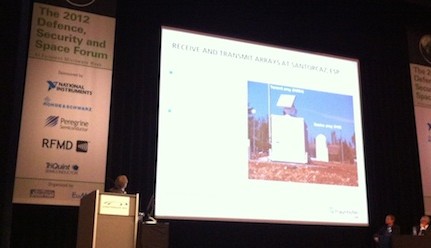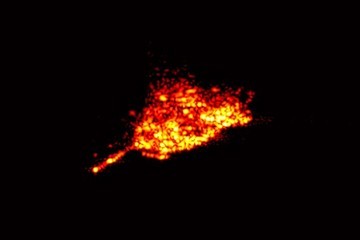European Microwave Week: Space Surveillance Systems
November 01, 2012
on
on

‘We need security for our space systems but also against our space systems. To protect ourselves we need space situational awareness. And the most important sensor to give us that is radar’, said Joachim Ender professor at the German Frauenhofer Institute for High Frequency Physics and Radar Techniques.
Ender held one of the keynote speeches at the Defense, Security and Space Forum, part of the European Microwave Week (EUMW). EUMW is held each year at a different location. The 15th edition is taking place from October 28 to November 2 in Amsterdam, The Netherlands. Microwave Week also includes The European Microwave Conference (EuMC), The European Microwave Integrated Circuits Conference (EuMIC) and The European Radar Conference (EuRAD).
Near-earth space
In his keynote Ender expanded on the threats space based systems face, the need for space surveillance systems and -because it was Microwave Week- the importance of radar.
The use of near-earth space is rapidly increasing. It is used for navigation satellites, communication systems, space observation and military surveillance. Over time society has become considerably dependent on space based systems. If those systems would break down it would have a huge impact on our daily lives.
But space is a hostile place and the artificial satellites placed up there face all kinds of threats. There is the risk of collisions with space debris, celestial bodies like meteorites and each other. Space weather is another danger, in particular sun eruptions which can interfere with the electronics of spacecrafts. And then there is the threat of human aggression. Satellites can be destroyed from the ground or from space. Or hostile forces could intercept or interfere with the data links.

Radar image of the German ROSAT satellite a day before it re-entered earth's atmosphere uncontrolled. Taken by Tracking and Imaging Radar (TIRA) of the Frauenhofer Institute.
Collisions
There are about 606,000 objects larger than 1 cm in diameter in near-earth space, 20,500 of these are larger than 10 cm. These small objects are capable of destroying a satellite. And unfortunately the density of space debris is growing rapidly as a result of human action.
In 2007 a Chinese missile destroyed a Chinese satellite. In 2008 the US too destroyed one of its own with a missile launched from a warship. And in 2009 a Russian and an American satellite accidentally collided. At each of these incidents the density of debris increased by a factor two. ‘In ten or twenty years this part of space may not be usable anymore because of a chain reaction leading to the exponential growth of debris’, Ender said.
There are also threats from space. Space objects re-entering earth’s atmosphere uncontrolled can pose a risk if they weigh more than a ton. In November 2011, 20 tons of mass came down as the Russian Phobos Grunt satellite re-entered.
Space surveillance systems
To increase the knowledge about all the possible threats and have a better chance at averting them, space surveillance systems are put in place and continuously improved. The United States has a Space Surveillance Network consisting of a network of radar systems, optical telescopes and other sensors spanning the globe. It has about 16,000 objects in its public catalogue and a few thousand in a classified log. Europe has a space situational awareness system too with 2500 objects catalogued. The former Soviet Union also had a space surveillance system but Ender said he had no details on how it operated in the present day.
Radar
Radar is the most important tool to provide space situational awareness. It has properties that makes it especially suitable for space surveillance. It can penetrate the atmosphere, it isn’t dependent on sunlight so it is operational 24/7, it has high detection probabilities and a very wide range of thousands of kilometers.
With radar a space object at an altitude of 500 km can be observed over an arc of 4930 km for a duration of 650 seconds. To be able to achieve such ranges the radar system needs a lot of power and high-gain antennas. This makes the system very large meaning that –for now at least- space surveillance systems will be ground based because it is too expensive to launch them into space.
Photo: Joachim Ender at the Defense, Security and Space Forum
Radar image via Space.com
Ender held one of the keynote speeches at the Defense, Security and Space Forum, part of the European Microwave Week (EUMW). EUMW is held each year at a different location. The 15th edition is taking place from October 28 to November 2 in Amsterdam, The Netherlands. Microwave Week also includes The European Microwave Conference (EuMC), The European Microwave Integrated Circuits Conference (EuMIC) and The European Radar Conference (EuRAD).
Near-earth space
In his keynote Ender expanded on the threats space based systems face, the need for space surveillance systems and -because it was Microwave Week- the importance of radar.
The use of near-earth space is rapidly increasing. It is used for navigation satellites, communication systems, space observation and military surveillance. Over time society has become considerably dependent on space based systems. If those systems would break down it would have a huge impact on our daily lives.
But space is a hostile place and the artificial satellites placed up there face all kinds of threats. There is the risk of collisions with space debris, celestial bodies like meteorites and each other. Space weather is another danger, in particular sun eruptions which can interfere with the electronics of spacecrafts. And then there is the threat of human aggression. Satellites can be destroyed from the ground or from space. Or hostile forces could intercept or interfere with the data links.
Radar image of the German ROSAT satellite a day before it re-entered earth's atmosphere uncontrolled. Taken by Tracking and Imaging Radar (TIRA) of the Frauenhofer Institute.
Collisions
There are about 606,000 objects larger than 1 cm in diameter in near-earth space, 20,500 of these are larger than 10 cm. These small objects are capable of destroying a satellite. And unfortunately the density of space debris is growing rapidly as a result of human action.
In 2007 a Chinese missile destroyed a Chinese satellite. In 2008 the US too destroyed one of its own with a missile launched from a warship. And in 2009 a Russian and an American satellite accidentally collided. At each of these incidents the density of debris increased by a factor two. ‘In ten or twenty years this part of space may not be usable anymore because of a chain reaction leading to the exponential growth of debris’, Ender said.
There are also threats from space. Space objects re-entering earth’s atmosphere uncontrolled can pose a risk if they weigh more than a ton. In November 2011, 20 tons of mass came down as the Russian Phobos Grunt satellite re-entered.
Space surveillance systems
To increase the knowledge about all the possible threats and have a better chance at averting them, space surveillance systems are put in place and continuously improved. The United States has a Space Surveillance Network consisting of a network of radar systems, optical telescopes and other sensors spanning the globe. It has about 16,000 objects in its public catalogue and a few thousand in a classified log. Europe has a space situational awareness system too with 2500 objects catalogued. The former Soviet Union also had a space surveillance system but Ender said he had no details on how it operated in the present day.
Radar
Radar is the most important tool to provide space situational awareness. It has properties that makes it especially suitable for space surveillance. It can penetrate the atmosphere, it isn’t dependent on sunlight so it is operational 24/7, it has high detection probabilities and a very wide range of thousands of kilometers.
With radar a space object at an altitude of 500 km can be observed over an arc of 4930 km for a duration of 650 seconds. To be able to achieve such ranges the radar system needs a lot of power and high-gain antennas. This makes the system very large meaning that –for now at least- space surveillance systems will be ground based because it is too expensive to launch them into space.
Photo: Joachim Ender at the Defense, Security and Space Forum
Radar image via Space.com
Read full article
Hide full article


Discussion (1 comment)